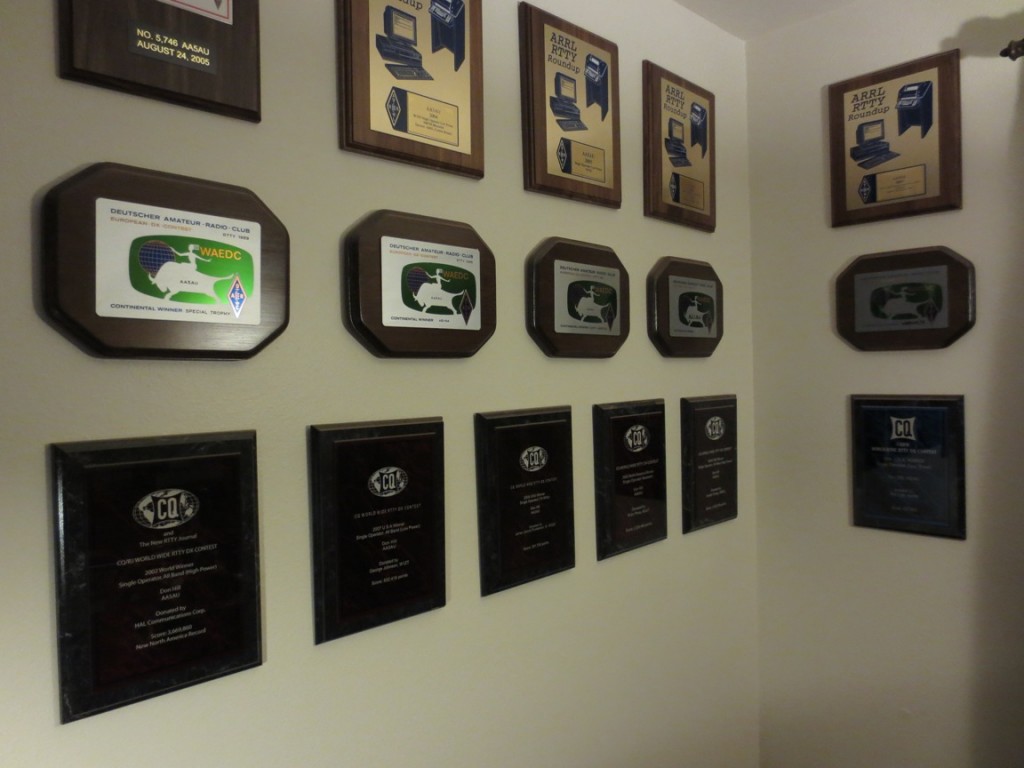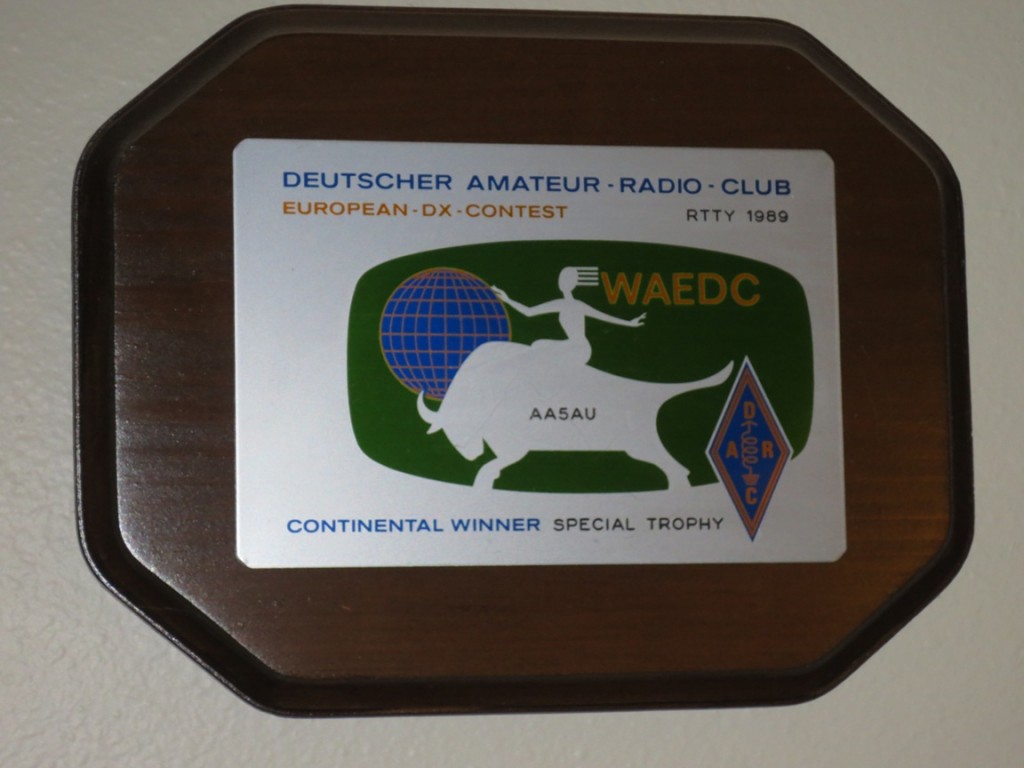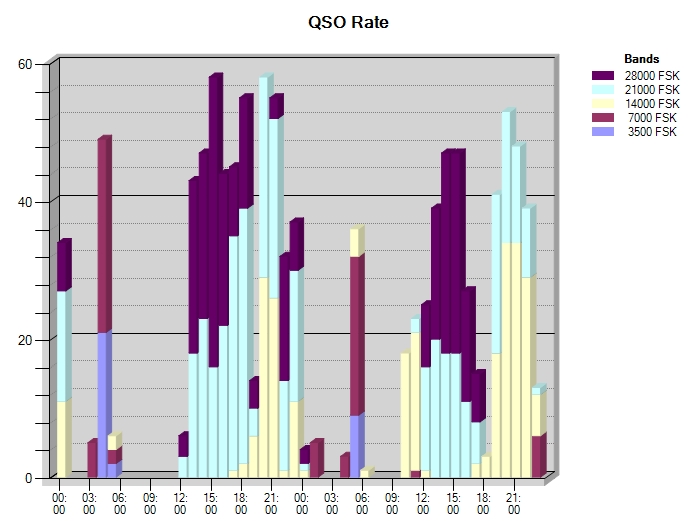AA5AU Contest Notes – 2014 WAEDC RTTY Contest
The 2014 Work All Europe DX Contest for RTTY mode (WAEDC RTTY) took place on November 8th and 9th. WAEDC RTTY is one of my favorite RTTY contests because of the rules which allows contesters to exchange QTC information for additional points. My history with WAEDC goes back to the mid-1970s when I was a teenager in high school. The DX club Indy DXers took me under their wing and showed me the ins and outs of contesting on CW and SSB. In 1975, one of the members, Les Banon, allowed me to use his station for a single-op high power (there was no power classes back then) effort in the WAEDC CW contest. (I don’t remember Les’ W9 call but he eventually moved to Texas and became WF5E and was world famous for his QSL service.) Anyway, back in Indiana, I placed first in W9-land (10th USA) that year and received my first ever major contesting award – a WAEDC certificate. I had just graduated from high school and was 18 years old.
Those early years of exchanging QTC traffic on CW would later help me realize how important they are in RTTY contests too. In the late 1980s, after moving to Louisiana and by using a single-radio, two-computer setup (two Heathkit H-89 computers under the CP/M operating system), I was able to win North America in three WAEDC RTTY contests even though I only had a modest station and no yagi antennas. I would generate QTC messages on floppy disk on one computer, then transfer the disk over to the other computer which was running RTTY (using a homebrew terminal unit and homebrew software). I sent QTCs by sending the file which contained the pre-typed QTCs from the other computer. To receive QTCs, I would just do a file capture to disk. All this was very revolutionary for WAEDC and it earned me three plaques. I would win NA again in 1991 for my 5th plaque. Why five plaques instead of four? I’m not 100% sure but I think that perhaps in 1989 I won both all-band and high-band categories for North America (the high-band category was eventually dropped). In any case, I have five WAEDC plaques on the wall (see photo below). A couple of them came without being mounted. A couple of years ago I bought five pieces of wood, stained them and mounted the plates. They hang proudly on the shack wall. They are really cool plaques.
After 1991, I only operated WAEDC RTTY seriously 3 times – 2000, 2001 and 2013. In 2000, I won USA W5-land (2nd USA) high power with 446,545 points. I wasn’t able to operate in many WAEDC RTTY contests because in most years it coincided with the opening of duck season in Louisiana and I was an avid duck hunter.
In 2001, I had my best effort up to that time by placing 2nd World non-Europe (high power) with 1,023,776 points behind Mike, K4GMH. Then last year I entered low power for the very first time in this contest and came in 3rd World and second USA behind ZZ2T and WE4M (Mark N2QT who is the current Low Power world record holder in WAEDC RTTY). The Low Power category was added in 2002. What’s interesting about last year’s effort is that I didn’t even remember it and had to look it up before writing this!
Earlier in the week before the contest, I received email from Mark (N2QT) stating he would not be able to operate because he had too many other things to do. (Besides winning the World Low Power in 2009, 2011 & 2012, Mark had a six-year North America win streak going from 2008-2013). I replied to Mark that I probably wouldn’t be able to operate either. My priority for the weekend was to get FT4TA, Tromelin Island, in the log on 80 and 30 meters. Plus the XYL had been piling chores on me left and right and I just knew she was going to come up with something this weekend (she actually did but I’ll get to that later). I told Mark I would be lucky to get to operate any of the contest.
I took Friday off from work to meet with a HVAC repairman. My heater went out. Contrary to popular belief, you do need heat in the winter in Louisiana. That was proven well last year! The guy didn’t show up until late in the afternoon. During the day I was messing around in the shack and decided to go ahead and set up for the contest just in case I was able to get some seat time. After the repairman left, it was getting close to the start of the contest. I decided beforehand I would go SO2R low power. When the contest started, which was right around my sunset, I started on 10 and 15 meters and found the bands to be open to Asia and I starting making contacts on both radios. Ten minutes into the contest, the XYL called for dinner. Despite the bands being open, I wasn’t about to miss dinner. I was hungry! I had just worked my good friend Jay, WS7I, on ten meters. I asked if he wanted my run frequency and he graciously declined. I went to eat.
When I returned from dinner 20 minutes later, 15 was still open, but ten was gone. I moved that radio to 20 meters and worked both 15 and 20 meters for about 20 minutes when I spot came out on the cluster for FT4TA on 80 meter CW. I had tried to work them on 80 CW a couple times earlier in the week but was unsuccessful. I heard them well both times using my Pixel Loop antenna. Transmitting 700 watts into my 80 meter inverted vee with apex at only 40′ just didn’t make it. This time I listened for them and they were readable but not as strong as previous days and with QSB. I knew it wouldn’t be easy, but I really wanted to get them on 80 so I joined the pileup at around 0055Z. At 0219Z, I finally worked them and was extremely happy and proud. You know the feeling.
They were also on 30 meter CW that evening, so I went there and found they had an excellent signal so started calling. But I didn’t have much confidence on 30. I don’t have a 30 meter antenna since losing the 30/40 loop dipole on my SteppIR yagi to Hurricane Isaac in 2012. Even though I have all the parts to put it all back up, open heart surgery just over a year ago set back any repairs and I hadn’t climbed either tower since then. So I am forced to use my 40 meter inverted vee with an antenna tuner for 30 meters. It’s my best 30 meter transmit antenna and even better than my 80 meter inverted vee. Not sure why, but that’s just the way it is. And it’s not very good. I called and called and finally at around 0330Z they went QRT from 30. I didn’t make the contact. You know that feeling too.
I restarted the contest at 0344Z on 40 and 80 meters. My low band antennas are crap but I messed around until 0515Z. Before pulling the plug, I checked twenty meters and found a few signals and was able to receive QTCs from RG9A, then went to bed. I only had 94 contacts. This was starting out as yet another casual effort but it really didn’t matter because I felt lucky just to be able to operate.
I slept in to about 6:30 AM Saturday morning (1230Z) and restarted the contest fifteen minutes later. It was just past my sunrise. I wasn’t surprised to see 15 meters open to Europe but when I found ten meters open to Europe, I knew conditions were good. With 10 & 15 meters open to Europe I proceeded to exchange as many QTCs as possible with as many stations as possible. Since I am very proficient at receiving QTCs, I devised a plan where I would request stations from other continents to send QTCs to me instead of me sending QTCs. Since it’s easier to send QTCs than to receive, I felt it likely that other stations would respond more positively to a request that they send QTCs rather than have them receive QTCs. It appears to have worked. I created a special macro to request other stations to send QTCs and it seems many stations were obliged to send.
Since I was running SO2R, by receiving QTCs on one radio, I could continue to make contacts on the other radios. If I were to transmit QTCs on one radio, I could not transmit on the other radio, making it basically useless. Since I started running on both radios, receiving QTCs was the best way to go. Receiving QTCs was very easy and made even easier by the fact that I was running multiple decode windows of 2Tone and MMTTY on each radio. This triple-decode setup was a real killer when receiving QTCs. Requests were repeats were rare.
There was another advantage to receiving QTCs that I had not planned on. By receiving QTCs, I could actually receive QTCs on each radio at the same time! I have to admit that the first time or two that I did this, it was very scary. But luckily I was able to figure out the best way to do this was to concentrate on the QTCs that started coming in first. So if I started receiving QTCs first on the left radio, I would concentrate on all those first, then turn my attention to QTCs being receive on the right radio. When I got real comfortable at this, I could then actually process received QTCs from each radio at the same time. If I needed a repeat, I could do that on the radio that finished first while the other radio was still receiving QTCs. I couldn’t believe how well this worked and it became a lot of fun doing this. So I made a very strong effort to receive QTCs from anyone worked outside of North America and the QTCs started piling up fast.
Ten meters started slowing down around 1755Z, so I went to 20 meters on that radio and worked a couple of stations but 20 was not very good yet, so I went back to 10 meters. Europe was still coming in on 15 meters and I was still able to pass QTCs with European stations around 1830Z, when the path to Europe was basically done. I was still able to pass QTCs to other stations – namely KH6ZM on 10 and YV5AAX on 15 meters but basically QTC traffic came to a standstill even when I moved permanently from 10 to 20 meters at 1900Z. Since it was slow, I took a small break to eat lunch and relax. The XYL had not called me for any chores, so at 2000Z I was back at the radios. I could work Europe on 20 meters but all the stations I worked I had already passed QTCs with except a few like DR60INN. I was able to receive QTCs from ZL2B on 10 meters and JG3FEA on 15 meters at 2135Z. That’s about when the JAs starting coming in on 15 meters. About an hour later, I moved the 20 meter radio back to 10 meters to work Japan and receive more QTCs. Starting at 2200Z, I was found more to receive QTCs from like LT0H, JA7IC (on 10M), JA3QOS, 7N2UQC, JR4OZR. But after 2300Z, it got slow again.
At 0001Z, a spot came out for FT4TA on 30 meter RTTY. I went to 30 meters and they had a very nice signal on my 40 meter inverted vee so I started calling them. At 0012Z I worked them to complete the bands I needed which were 10, 12, 30 and 80 meters. I took a short break and rejoined the contest. Appears the contest was starting to become a more serious effort than planned. I worked a few minutes when the call came for dinner. After dinner I relaxed and watched TV with the XYL. At around 0500Z, I decided to check 40 and 80 meters and worked a few stations. At 0536Z, I checked 20 meters to find nice signals from Europe. I received QTCs from YP0C and RX1CQ but it was slow. Most of the stations I was hearing, I already worked and received QTCs from. I was a bit tired so at 0615Z, I went to bed.
I only slept 4 hours. When I woke up I checked 20 meters and found big signals from Europe. I worked many of the stations I had worked previously on 10 and 15, and only received QTCs from IM0/IK0FMB. 9A7R, GU0SUP, YL2NN. At the same time I was S&P on 40 meters but only worked one station there – K4ADR. At 1150Z, I found 15 meters opening to Europe. About an hour later, 10 meters opened to Europe and I was back running both 10 and 15 meters and receiving QTCs again. QTC traffic was in excellent supply all morning on both bands and again, when I could, I was receiving QTCs on both radios even at the same time. That morning I received 360 more QTCs and sent 40. After 1800Z, it really slowed down. I was switching one radio back and forth between 10 and 20 meters while keeping the other on 15. The bands were still good, maybe not as good as Saturday, but it was getting to the point where it was harder to find stations to work.
20 meters was not great to Europe but it got better after 2130Z when I was able to receive QTCs from DL9NCR, DJ8EW and G0RPM. I sent QTCs to YT2U and EB2RA. I was working hard to find new stations to pass QTCs with. VK3TDX called in longpath and sent me ten more QTCs. At 2321Z, I worked VR2XMT on 15 meters. The XYL asked me to go to the grocery store, so I went QRT.
Guess I got much more seat time than planned. I just love when that happens. Hope it happens again next year.
3830 Post
Call: AA5AU
Operator(s): AA5AU
Station: AA5AU
Class: Single Op LP
QTH: LA
Operating Time (hrs):
Location: USA
Radios: SO2R
| Summary: Compare Scores | ||||||
| Band | QSOs | Pts | QTCs | Mults | ||
| 80: | 32 | 0 | 16 | |||
| 40: | 73 | 60 | 30 | |||
| 20: | 260 | 200 | 70 | |||
| 15: | 418 | 568 | 92 | |||
| 10: | 292 | 602 | 77 | |||
| Total: | 1075 | 0 | 1430 | 285 | Total Score | 1,583,160 |
Club: Louisiana Contest Club
| Comments: [email] 2014-11-09 16:49:52 |
| Didn’t plan on spending this much time in the contest. The priorities for the weekend were to get FT4TA in the log on 30 and 80 meters. I spent a good bit of time calling them on 80 CW Friday night before finally making the contact. Then did the same Saturday evening on 30 meter RTTY and worked them there to complete the bands I needed. Conditions were pretty good. Glad it was a “Work all Europe” contest because there were a LOT of Europe! Fifteen was the best overall band for QSOs and mults but ten was king for QTC traffic. Having not done serious efforts in this contest for a couple few years, I decided to go back to what I do best – low power. Running SO2R I devised a plan to RECEIVE as many QTCs as possible. With two 2Tone decode windows and one MMTTY window on each radio, receiving QTCs are nearly painless. While RECEIVING QTCs I could still transmit legally on the other radio. This strategy worked very well. Out of 1430 QTCs logged, I only sent 220 of them. In my case, it’s better to RECEIVE than to give. HI There are still a lot of people who shy away from QTC traffic but that’s OK. And there are still some in Europe who believe they can only receive QTCs. In those cases I had to send mine. It was not a 100% all out effort. I took a lot of breaks and some time off to help the XYL clean up the garage Sunday and took some time to go to the grocery store before the end of the contest. After working FT4TA on 80, then on 30 meters, I didn’t go back to the contest on the low bands and thus my low band totals are, well, low. One observation the past couple of RTTY contests. With the popularity of JT65 and JT9, the low end of the 10, 15 and 20 meter RTTY sub-bands are now .080. I looked below .080 a couple of times on those bands but did not hear any RTTY signals. I think this is a good thing. I had a lot of fun. I really enjoy exchanging QTCs. It’s a challenge, but with 2Tone and multiple decode windows, it’s much easier than back in the day. Thanks to everyone for the contacts. I don’t know when I’ll get a chance at another decent effort in this contest so glad I was able to get some good seat time this year in case conditions start to go down. |



